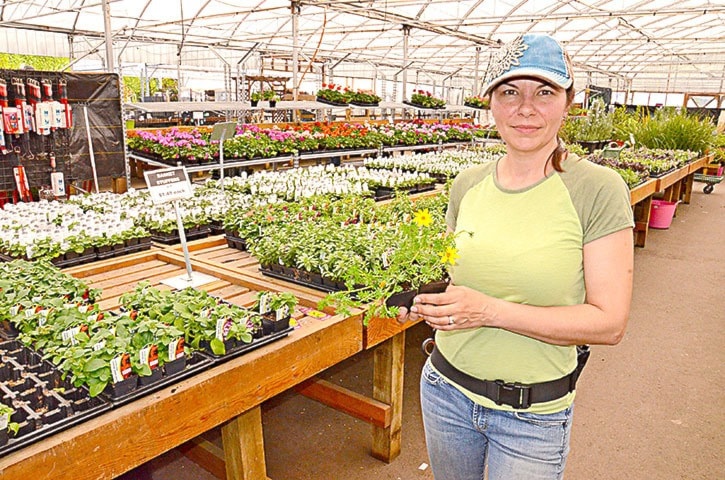As soon as the sun comes out in spring, residents are eager to see their yards, balconies and even businesses burst with blooms.
Many turn to hanging baskets but a few warm days doesn’t mean it’s time to put them up.
“Mid-May on is best,” explained Shelley Levis, a gardening blogger (sowanddipity.com) and Art’s Nursery retail manager for seasonal stock. “It’s due to cold and chilly nights.”
The nights have to be consistently above 10 degrees Celsius.
Mother’s Day is the biggest time for hanging basket sales.
“They go together like peas and carrots,” she said.
Clearly, Canadians have found hanging baskets colourful and convenient. In 2013, Canada produced 11.5 million hanging baskets.
Baskets have several advantages, explained Shelley Murley, the instructional associate of production in the Faculity of Science and Horticulture at Kwantlen Polytechnic University.
“Small spaces can be utilized with hanging baskets,” she said. “Baskets solve the problem of poor soil. Baskets don’t get trampled upon, and their tight plantings not only offer solid balls of colour but virtually eliminate weeding. Hanging baskets are portable, giving you a new look in an instant anywhere in your yard.”
Most wild flower eaters (rabbits and deer) don’t typically go for hanging baskets.
Murley said one other feature of hanging baskets makes them an attractive choice.
“You rarely will find the neighborhood pet in a hanging garden,” she quipped.
As for care, people have to be careful not to let them get too dry (the soil shrinks back from the sides of the pots and water will flush down the sides without nourishing the roots). As well, too much water is bad, leaving the roots in water.
“Water in the morning if possible allowing the leaves to dry out before night time reducing disease risks,” Murley said.
The basket soil should have a dry, damp sponge kind of feel and must have drainage.
Levis added that during the hottest days of summer, she waters her baskets daily. She also turns her baskets every couple of days so each side gets more even exposure to the sun and grows more evenly.
Murley likes to use a 20-20-20 water soluable fertilizer once or twice a week. Levis said she uses a water soluable as well as a slow-release fertilizer because the plants have a lot of growing to do in a short season.
Wilting usually means the baskets aren’t being watered enough, but it can also mean disease, Murley noted.
“Yellowing leaves may mean the plants aren’t getting enough nutrients. Brown spots, chewed leaves, sticky substances and discoloration are typical signs of bugs inhabiting your plants,” she said.
Remove dead flowers to keep the basket looking good and to encourage more flower development. Cut back stems growing too long to keep a nice uniform shape and encourage the plant to produce new growth, Murley added.
The hardest part for any gardener is cutting but both say it’s needed to keep the basket growing and beautiful. Levis said plants such as lobelia can get spindly and should be cut back by half, even if it means losing a few flowers. The plant will come back with more lush growth.
Baskets offer convenience and the ability to put plants where it isn’t possible to garden, but Murley noted people need to think about weight.
“Whatever you are hanging them from, you must be sure the structure can support them,” she said. “Also consider the amount of sun, shade and rain water they are likely to get.”
Levis explained that many plants need a great deal of light to flower so don’t do well in shady areas. But there are many plants with colourful leaves that make nice basket stuffers. She suggested herbs or varieties of lettuce for shady baskets and people can even take their indoor tropical plants and use them in hanging baskets for the summer.
Levis’ general rule for deciding on what to put in baskets, for those who choose to make their own, is “thrillers and spillers.” The plants should be appropriate for a basket (not grow too tall), be eye-catching (the thrillers) and hang over the side (the spillers).
“Direct them so the root ball is at an angle for spills,” Levis said. “It will get them to grow in the right direction quicker.”

PHOTO: If making a hanging basket, don’t hesitate to ask nursery staff for tips on appropriate plants. (
Heather Colpitts/Langley Advance)
